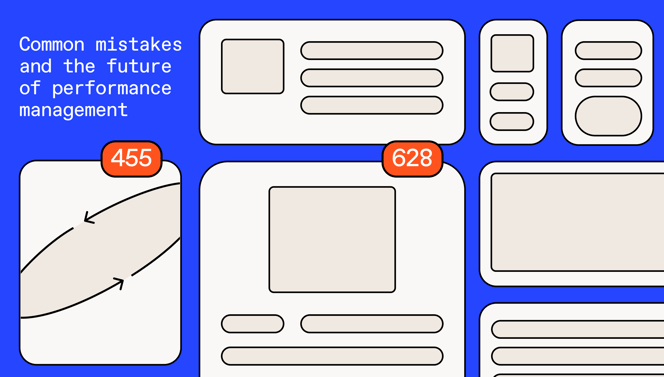Performance management — where success and growth intertwine. But what exactly is the performance management cycle?.
Picture it as the heartbeat of your organization, pumping life into employee development and business progress.
It's your strategy compass, ensuring employees and teams are thriving, aiming high, and achieving greatness when each part of the entire performance management cycle falls in line with the rest.

Lead high-performing employees
Discover modern ways of handling performance management to become the coach your team needs.
How to master the performance management cycle
Why it matters
The performance management cycle leads to HR excellence. It acts as your navigational map, leading you to destinations where clear expectations and connecting individual aspirations with the overarching organizational goals help bring the best out of your employees.
It serves as a reliable route to continuous growth, offering waypoints of ongoing learning through regular feedback and tailored development plans.
Like a compass pointing to engagement, performance management cycles facilitate constant communication and provide direction through the guidance of feedback.
It ensures that rewards and recognition are like landmarks, reflecting significant achievements, while also supplying data as a valuable cartographic resource for strategic HR decisions, including promotions and talent mapping.
The performance management cycle model
Breaking down each phase of the entire performance management cycle will help you optimize workforce potential, as each is a milestone on the path to elevated productivity and employee engagement.
Planning phase: Navigating the start of a performance management process
During the planning phase of the performance management cycle, you lay the foundation for success. This phase encompasses several crucial steps that chart the course for an effective performance management process.
- Goal setting: Begin by defining clear objectives for your employees. These goals should align with the overarching organizational aims. Remember to adhere to the SMART criteria. Find goal-setting tips here!
- Role clarification: Ensure every team member comprehends their role and responsibilities. Provide them with a well-defined job description, outlining their tasks so they can feel empowered in their contributions.
- Setting performance standards: Develop the criteria that will be used to evaluate an employee's performance. These standards could be based on work quality, quantity, efficiency, or other role-specific metrics.
- Performance expectations: Clearly communicate the expectations in the performance cycle to your employees. They should understand what's required of them and the distinction between acceptable and outstanding.
- Planning for development: Identify potential skills or competency gaps and devise a development plan. This could encompass opportunities for training, mentorship, or job rotation to foster growth.
- Resource allocation: Ensure that your employees have the necessary resources to effectively fulfill their roles. This could encompass equipment, technology, training, or support from colleagues.
💡Expert tip: Involving your employees in the planning process can seriously boost engagement! We’re talking more than just communicating your plan: it’s about active participation, where employees help set their own performance standards and goals. This is just one of many performance management cycle strategies.
Why collaborative planning matters
When employees become active architects of their goals, their engagement and commitment to achieving them solidifies.
Involving employees in this phase also enhances the realism of set goals, as they have a keen understanding of their workloads and skills, creating achievable performance standards.
Open communication also helps tailor more effective skill development plans, since employees are just as aware of where they might need a bit of a boost.
Monitoring phase: Keeping a watchful eye
The monitoring phase is about actively observing and assessing how well goals are being pursued and how progress is being made. This critical phase ensures that everyone is on the right track and moving in sync.
There are many tools and techniques to use to your advantage in monitoring employee performance:
- Performance appraisal systems: Think of these as digital scorecards that managers use to evaluate and track employee performance against predefined goals and objectives.
- Project management tools: Tools help keep tabs on tasks, workflows, and contributions to projects. Having a planner that guides you through the day's tasks is essential.
- Employee surveys: Regular surveys help measure employee satisfaction, engagement, and how they perceive their own performance. Checking the team's health regularly ensures everyone's doing well.
- 360-degree feedback: A full-circle view of performance involves gathering feedback from various angles: peers, supervisors, and sometimes even customers. Being able to see performance from all sides gives you a more comprehensive understanding.
- One-on-one meetings: Check-ins with a manager can be formal or informal. They're great for monitoring progress, discussing challenges, and adjusting goals if needed.
- Key performance indicators (KPIs): KPIs are performance benchmarks and they vary from one organization to the next. Sales revenue, customer satisfaction scores, number of resolved customer support tickets... quantifiable metrics that reflect how well objectives are being achieved.
Real-world success: How Assent used Officevibe to launch new EX programs
Assent Compliance is a great example of how a business can effectively use monitoring to optimize its performance management cycle strategy.
By using real-time engagement monitoring, they kept their finger on the pulse of their workforce to optimize their HR processes.
Development planning stage: Crafting growth
The development planning stage selects the route leading each employee to success. It's about intentionally growing skills and knowledge to improve not only their own performance but also the success of the entire team and organization.
Development plans have a big impact on performance and business outcomes, including:
- Enhanced skills and competencies: Development initiatives, like training programs and workshops, are like power-ups for your skills. As you learn more, you become better at what you do, boosting your performance.
- Increased productivity: Imagine development as upgrading your toolkit. Learning new skills or enhancing existing ones can make you more efficient and effective in your role, like having the right tools for a construction job.
- Improved employee engagement: Development is an investment that shows employees that they are valued, leading to a stronger sense of belonging and engagement, and propelling overall performance forward.
- Reduced turnover: Development opportunities are like anchors for employees. When they have chances to grow, employees are less likely to leave, saving the company resources spent on hiring and training new team members.
- Succession planning: By growing employees' skills, businesses create a pool of talent ready to step into leadership roles when the time comes. This ensures a smooth transition and keeps the organization steady.
Review phase: Assessing progress
Tips for mastering performance development
Every journey is different, as each employee has unique strengths, weaknesses, and aspirations. So customize development plans for each individual to address their needs and goals.
But don’t just stick to traditional training — leverage a variety of development methods. Think mentorship, job rotation, or even self-guided online learning.
At the end of the day, development is an ongoing process, so encourage a culture of continuous learning amongst your employees. The more you learn, the better you become.
The review phase is the time to pause and reflect on performance journeys so far, taking a moment to evaluate how things are going for a chance to chart a course for the future.
It's important to conduct reviews in a timely and accurate manner that includes:
- Feedback for improvement: Valuable feedback is constructive. It's like a GPS telling you if employees are on track or if there's a detour ahead. The more regular reviews you conduct, the more often you can help them improve their performance.
- Effort recognition: Reviews are opportunities to celebrate achievements and acknowledge the hard work of your employees. This seriously boosts morale and motivates employees to continue to do their best.
- Career development opportunities: Reviews are moments to chat about the next steps for employees, as these discussions provide insights into progress and a roadmap for advancement.
- Addressing issues: Reviews provide solutions. By addressing minor issues promptly, you prevent them from becoming major roadblocks.
- Employee engagement: Timely reviews show that the organization cares about its employees' journeys. Active investment in their growth boosts engagement and job satisfaction.
Take a deeper dive into conducting great performance reviews.
Making reviews work for you
Before embarking on any adventure, preparation is key. Collect your tools — review performance data, past feedback, and notes — to ensure a comprehensive evaluation.
The rest is all about balance, acknowledging strengths while addressing areas for improvement, and maintaining a balanced perspective. Remember, the review phase is just a waypoint, not the end of the journey.
Post-review, outline discussed actions and next steps. Schedule a follow-up to stay on course and address concerns that emerge.
Rewards and recognition phase in performance management cycles
Rewards and recognition play a vital role in the performance management cycle. It's all about acknowledging and appreciating employees' efforts and achievements to boost morale — especially when the going gets tough.
- Motivation boost: Who doesn't need a bit of a boost once in a while? Rewards and recognition do just that and heightened motivation translates into increased productivity and performance.
- Employee engagement: When feeling valued for their contributions, employees become more engaged in their work. Engaged employees demonstrate a deeper commitment to their roles and are more likely to go the extra mile.
- Job satisfaction: Recognition directly influences job satisfaction. Why would you love a job that doesn't love you? When employees are recognized for their hard work, their morale improves, enhancing their overall attitude toward their tasks.
- Retention: Recognized employees are more likely to stay with the organization. We're talking lower turnover, and reducing the costs and disruptions associated with recruiting and training new employees.
- Positive work culture: Cultivating a culture of recognition fosters a positive work environment. Witnessing colleagues being acknowledged encourages everyone to perform at their best.
Recognition success story
Read all about Aunalytics, who took their low recognition score seriously. By valuing the impact that recognition has on employee happiness and performance, they created a genuine culture of recognition that improved employee metrics ten-fold!
Common mistakes in performance management (and how to avoid them)
The performance management cycle can hit a few bumps, but fear not — we've got your back. Let's dive into two common slip-ups and how to sidestep them.
Infrequent feedback and communication
Is feedback coming your way only once in a blue moon during formal review sessions or even just twice a year? Yikes! This can lead to missed chances for growth, and misalignment between your goals and the company's vision.
How to avoid this
To steer clear of this pitfall, build a culture of ongoing feedback and regular check-ins. Think weekly catch-ups or monthly chats.
Staying in the loop ensures timely tweaks, keeps everyone aligned, and helps you see how your work jazzes up the company's game.
Overemphasis on areas of improvement
Imagine getting a magnifying glass on your not-so-strong points. Ouch, right? It's true, focusing too hard on what's not your best can deflate your enthusiasm and mojo.
How to avoid this
Instead of dwelling solely on the downside, let's go for the gold — a balanced approach. Give a round of applause for your wins and shine a spotlight on your strengths, while still keeping tabs on areas that could use a spruce-up. The strength-based approach is where it's at!
The future of the performance management cycle
Get a glimpse into the future of performance management, with the latest performance management cycle trends and innovations that are reshaping the way we nurture our teams.
Current trends and innovations in the performance management cycle
Capitalize on these trends to keep your performance management cycles dynamic and fresh:
Continuous performance management cycle
The annual review is getting a makeover as organizations shift to more frequent evaluations. This means addressing issues in the moment, fostering rapid skill growth, and nurturing a culture of constant improvement [1].
Real-time feedback
The performance management process taps into technology's power, offering instant feedback. This real-time guidance fuels ongoing growth and development for employees [1].
Personalized performance management cycle
Recognizing the diversity in strengths and areas for growth, companies are customizing performance plans. It's like a tailor-made suit, designed to fit each individual's unique needs and aspirations [1].
Employee engagement and empowerment
Businesses are doubling down on initiatives that engage and empower their employees. A motivated and empowered workforce is proven to perform better, giving a boost to both morale and productivity [1].
Predictions for performance management
Short of having a professional crystal ball, these trends are on the rise for performance management excellence:
Emphasis on the employee experience
Expect an era where the employee experience takes center stage. Successful organizations will be the ones who create nurturing environments that prioritize growth, learning, and well-being, ensuring everyone thrives.
Fusing learning and development
Expect the performance management cycle and learning initiatives to become close pals. Continuous skill development will be interwoven with performance improvement to foster a vibrant learning culture.
Continuous performance improvement is all about agile performance management. Adapting to change and the ever-evolving HR landscape is easy with tools like Officevibe.
Performance management cycle roadmap and performance expectations
The performance management cycle isn't just a strategy — from setting clear expectations to nurturing growth, engagement, and recognition, continuous performance management is the North Star of businesses.
So, HR leaders and fellow captains of industry, keep the performance management cycle close to your helm and chart a course to excellence... with the right equipment!

Lead high-performing employees
Discover modern ways of handling performance management to become the coach your team needs.



